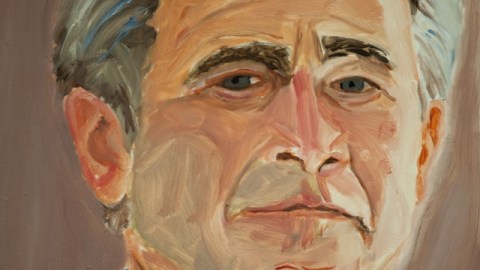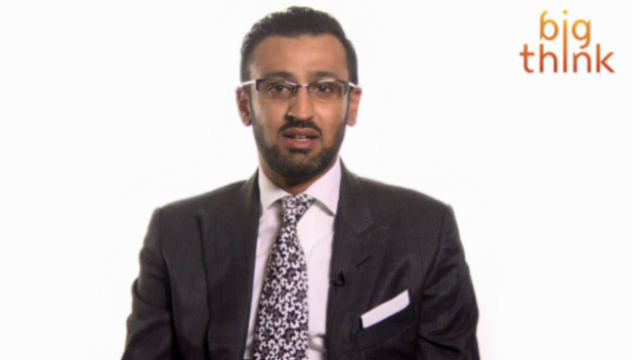Why Does George W. Bush Paint (and Why Do We Look)?

When former President George W. Bush’s self-portraits in the shower and tub slipped into public sight a year ago, the general critical approaches either commented on the amateur quality of the work, on the obvious symbolism of cleansing (if you were a critic and thought he had something to cleanse himself of), or on both. Bush allegedly took up painting less than a year before the revelations, making him the most viewed art rookie of modern times. Now, in a new exhibition at the George Bush Presidential Library and Museum titled The Art of Leadership: A President’s Personal Diplomacy, Bush puts his artwork out there for comment on his own terms. The art’s still amateurish, but the content—portraits of “41” and “43,” as the Bushes refer to themselves, as well as other world leaders—cries out for commentary beyond the brushwork. Why “W.” paints remains a bit of a mystery that he hasn’t fully cleared up. But why we look says as much about his legacy as it does about our continuing struggle to come to grips with it.
I fully admit that I have not seen the paintings in person. Few have. In her review of the exhibition in The New York Times, Roberta Smith goes into hyperbolic overdrive to complement the president’s portraits, comparing some to work by Luc Tuymans and Arnold Schoenberg, who is best known as a modernist composer but also reached a high level of Expressionist painting. “Mr. Bush has an uncanny ability to translate photographs into more awkward images enlivened by distortions and slightly ham-handed brushwork,” she writes, in what may possibly be the first review ever to use the words “awkward” and “ham-handed” favorably. Bush’s “skill may be disconcerting for people who love painting and dislike the former president,” Smith continues, “but still, everyone needs to get a grip, especially those in the art world who dismiss the paintings without even seeing them.” Haters gonna hate, Smith argues in Bush’s defense, after somehow turning “awkward” and “ham-handed” into a “disconcerting” kind of “skill.” There’s something disconcerting about Smith’s incoherent desperation to defend Bush’s political record as something separate from his artistic output. I’m guessing that she’s inarticulately trying to articulate a theory that Bush belongs in the critical category of folk artists who overcome economic, social, and sometimes mental challenges to create art, which justifies a different set of criteria when judging them against academically trained and sustained artists.
Of course, most folk artists don’t hire (according to Smith) “noted Dallas painter Gail Norfleet” to teach them. Still fewer folk artists exhibit their work in a library and museum named after them. Just as true folk artists are judged by different criteria based on their underprivileged situation, Bush needs to be judged on different criteria based on his overprivileged situation. “There’s a Rembrandt trapped in this body,” Bush allegedly told his teacher Norfleet. “Your job is to find it.” Bush never hurt for confidence, so I doubt some criticism of his work will hurt him.
The exhibit itself consists of 30 portraits accompanied by memorabilia (photographs, gifts, etc.) related to Bush’s interactions with the leaders portrayed. Russia’s Vladimir Putin, Britain’s Tony Blair, Afghanistan’s Hamid Karzai, Saudi Arabia’s King Abdullah, Germany’s Angela Merkel, and Israel’s Ehud Olmert, among others, find themselves the subject of Bush’s brush. It’s almost as if Bush is trying to paint a new picture of his relationships with these figures as one more unambiguously positive than the record allows. Just as Bush once famously claimed he could peer into the soul of Russia’s Putin, these portraits seem to claim artistically a similar clairvoyance.
But why does Bush paint? “Perhaps the biggest surprise of the show—contrary to the common caricature of laziness during his years in the White House,” Smith claims, “is that Mr. Bush has taken to painting with something amounting to driven passion, and is working very hard at it.” And, yet, that passion is mixed with “nonchalance,” which sounds like laziness to me. “Still Bushian nonchalance is not completely absent,” Smith continues. “The images seem legible and familiar, as if, as some have suggested, they were the first to pop up on Google.” So, first Bush is an awkward, ham-handed, yet good painter, then he’s a passionate, nonchalant practitioner. I doubt Luc Tuymans trolls Google for photographs to work from; if he does, he probably scrolls down a little. So, why does Bush paint, if not out of passion? I think it stems from Bush’s “inner Rembrandt” remark. Just as Bush’s father was accused of being born on third base and believing he hit a triple, Bush can be charged with having a museum show and thinking he’s Rembrandt. Dating back to his Yale days, Bush always resented those he perceived as “elites,” yet always wanted to beat the elites at their game. Through painting, Bush can pose as a Renaissance man, but never wants you to think he’s sweating for it, since only nerds work at anything.
But why do we look? I think we’re still looking for answers to all the lingering questions of the Bush years and the Bush wars. If Bush’s images of showers and bathtubs brought the psychoanalysts out of the woodwork, these portraits of the alleged accessories to his possible crimes against humanity in Iraq, Afghanistan, and Guantanamo will trigger even more heated analysis. I can’t help but remember cartoonist Matt Bors’ comic in response to the first revelations of Bush’s painting hobby. In the comic, a newscaster announces “Ten years after the invasion, President Bush is kickin’ back painting his feet.” In the next panel a war vet with two missing legs scowls. The Art of Leadership wants to be a celebratory party, but not everyone wants to celebrate an era still poorly understood. Despite Smith’s claims for the paintings’ quality, most viewers look at these paintings for content. Until that content actually reveals something about Bush the man or the leader beyond platitudes or misty watercolor memories of the way he wants us to think things were, we’ll all be scowling for more.
[Image:George W. Bush. Self-Portrait (detail). From the exhibition The Art of Leadership: A President’s Personal Diplomacy, which runs at the George Bush Presidential Library and Museum through June 3, 2014.]





